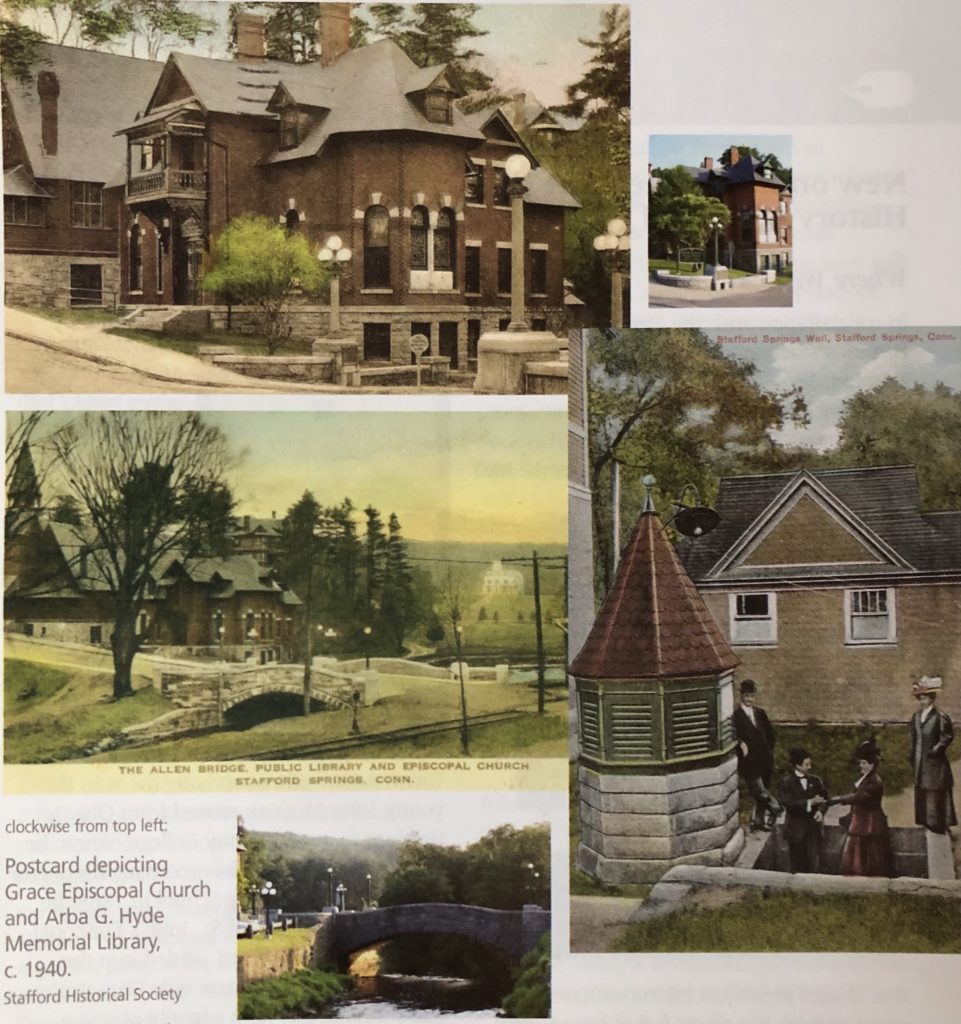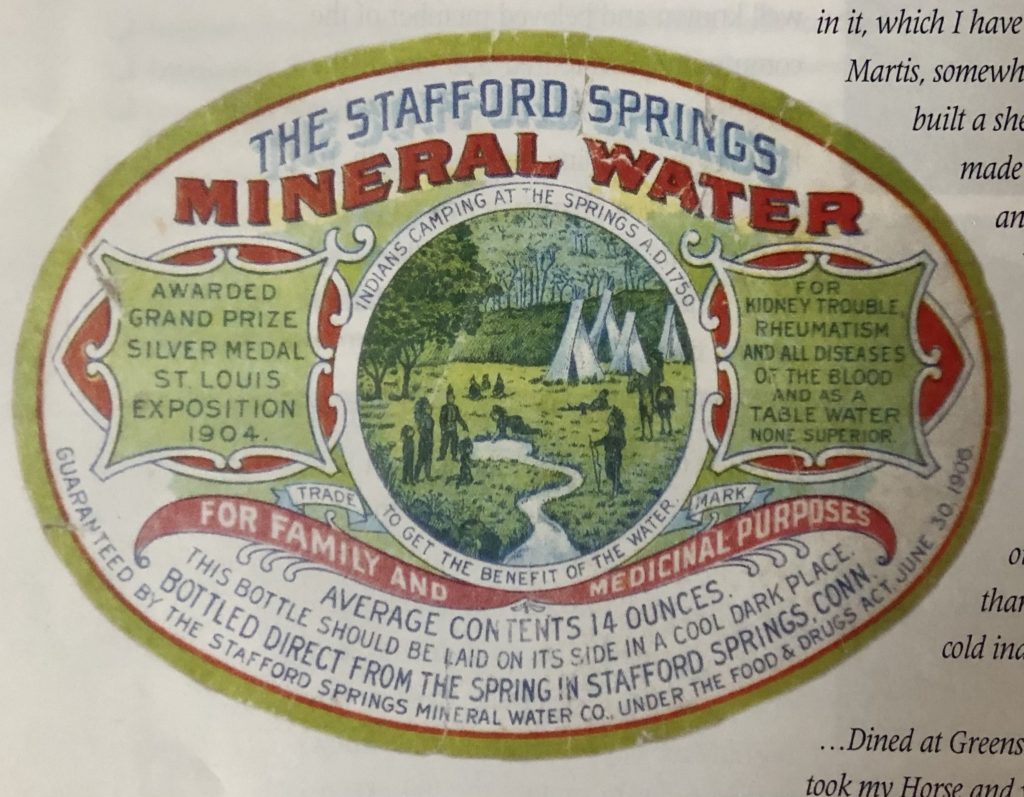By Andra Chantim
(c) Connecticut Explored Inc. Spring 2007
Subscribe/Buy the Issue!
John Adams, who served as second president of the United States from 1797 to 1801, was one of many who sought the curative powers of Stafford’s mineral springs. Adams suffered from poor health for most of his life, and a month after experiencing a series of physical ailments in February 1771, he decided to seek treatment in Connecticut. The passages excerpted here are from Adams’s journal account of his trip to America’s then most famous mineral springs. The diary is in the collection of the Massachusetts Historical Society.
1771. Tuesday. June 4th
Rode over to the Spring. One Childs had built a little House, within a few Yards of the Spring, and there some of the lame and infirm People keep. The Spring arises at the Foot of a Steep high Hill, between a Cluster of Rocks very near the Side of a River. The Water is very clear, limpid and transparent, the Rocks And Stones and Earth at the Bottom are tinged with a reddish yellow Colour, and so is the little Wooden Gutter that is placed at the Mouth of the Spring to carry the Water off – indeed the Water communicates that Colour, which resembles that of the Rust of Iron, to whatever Object it washes…It has a Taste of fair Water with an Infusion of some Preparation of steel in it, which I have taken, heretofore-Sal Martis, somewhat like Copperas. They had built a shed over a little Reservoir made of Wood, about 3 feet deep and into that conveyed the Water from the Spring, and there People bath, Wash and plunge, for which Childs has 8d. a time. I plunged in twice – but the 2d time was superfluous and did me more hurt than good, it was very cold indeed….
…Dined at Greens, and after 2 Hours by Sun took my Horse and went to the Spring again, and drank of the Water. Then I rode up the Mountain, at the Foot of which this Spring ooses. The Hill is high And the Prospect from it, extensive, but few cultivated Spots appear, the Horison is chiefly Wilderness…The Bottom and sides of the Cistern are painted a deep yellow, and a plentifull Dust or flour remains after the Water is drawn off. They say, that this yellow Sediment is the best thing for Scrophulous Humours, or any other Breakings out, Eruptions, Sores, Ulcers, Cankers &c….
1771. Wednesday June 5th.
Rode to the Spring, drank and plunged. Dipped but once. Sky cloudy. …About 11.0 Clock arrived, Dr. McKinstry of Taunton and spoke for Lodgings for himself and Co[lborn]Barrell and his Wife…I Joy and rejoice at his Arrival. I shall have Opportunity to examine him about this mineral, medicinal Water…30 People have been there to day, they say. The Halt, the Lame, the vapoury, hypochondriac scrophulous, &c. all resort here… .
Stafford’s mineral springs were discovered by the Nipmuck, who told the Puritans about them in hopes of forming an alliance against the Podunk. The springs attracted widespread attention—including that of John Adams—in 1764 when the story of one Mr. Field’s miraculous recovery spread throughout colonial America. Field, of East Windsor, was said to suffer from itchy “eruptions” on his face and body that were supposedly cured by bathing in the springs. Field’s was the first of many accounts published in newspapers, including the Connecticut Courant, wherein people claimed the Stafford waters cured them of their ailments.
In 1767 a direct stage route was established from Boston to Stafford Springs to capitalize on this budding resort’s popularity and make it more easily accessible. Through the early 1800s, visitors to the springs would stay at small hotels such as Child’s, Colburn’s, and the Green. In 1802, Dr. Samuel Willard bought the property and built the Stafford Springs House to accommodate patrons of the miracle water. His clientele grew as the springs’ reputation continued to spread, enabling Willard to expand the hotel.

top left: postcard, Grace Episcopal Church and Arba G. Hyde Memorial Library, c. 1940. Middle left: Postcard, Allen Bridge, Stafford Public Library, and Episcopal Church, c. 1915. Middle right: postcard, spring enclosure, c. 1905 – 1910. Stafford Historical Society. contemporary photos top right and bottom: Wise-Wire LLC, courtesy of the Town of Stafford
The Stafford Springs House continued to be popular through the 1840s and 50s. By the 1840s, though, the bottling of the magical water meant people didn’t have to travel to Stafford to take advantage of the cure. And the resort couldn’t compete with newer resorts like Saratoga Springs (which opened in 1871) that advertised festivities, liquor, gambling, and horse racing.
Whether the spring water actually had any medicinal benefit remains uncertain. Over two centuries, many swore by the Stafford water’s healing abilities while others, including John Adams himself, had doubts about its powers. Even the Connecticut Courant credited improvements in visitors’ health to the exercise and fresh air they got at the resort rather than to the medicinal water. Nevertheless, folks from all over colonial America claimed to walk away from Stafford healthy, refreshed, and with a new lease on life.
Visitors can see the original site of the mineral springs next to the Stafford Historical Society’s museum, where artifacts on display include original photographs and advertisements for the mineral springs, the hotels, and the Stafford Springs beverage bottles and labels. A word of caution, though: Don’t drink the water. It’s no longer considered potable, much less beneficial.
Andra Chantim was a student at Trinity College and served as intern last fall.
Explore!
Stafford Historical Society
5 Spring Street, Stafford
(860) 684-7978 or visit the society’s facebook page
For a more extensive excerpt from John Adams’s account of his visit to Connecticut and others’ tourist tales, see Connecticut Observed: Three Centuries of Visitors’ Impressions 1676-1940 (the Acorn Club, 1999).
“The Beechers Take the Water Cure,” Feb/Mar/Apr 2004
Read more stories about Health & Medicine on our TOPICS page.
Read more stories about Native Americans in Connecticut on our TOPICs page.
Subscribe to receive every issue!

